
 The refrigerator in my room makes noise that keeps me up at night, so I unplugged it and decided to leave my leftover pizza in the car. I expected that the pizza would stay cool... I did not expect that it would be frozen solid. The good news is that I was able to reheat my pizza for breakfast by setting the box on the dashboard of my rental car and turning the defroster on. 23 minutes on high thaws out and warms up a couple slices of Pizza Hut "Thin-n-Crispy" quite nicely. Breadsticks are thicker, and required 35 minutes. Breakfast is served.
The refrigerator in my room makes noise that keeps me up at night, so I unplugged it and decided to leave my leftover pizza in the car. I expected that the pizza would stay cool... I did not expect that it would be frozen solid. The good news is that I was able to reheat my pizza for breakfast by setting the box on the dashboard of my rental car and turning the defroster on. 23 minutes on high thaws out and warms up a couple slices of Pizza Hut "Thin-n-Crispy" quite nicely. Breadsticks are thicker, and required 35 minutes. Breakfast is served.
In-between jobs, I decided to take out my new Canon
Time to visit the beautiful Milwaukee Museum of Art.
I haven't been there since they remodeled years ago, and this was just the excuse I needed.
The review that follows is in-depth but not exhaustive. I've put the full text in an extended entry in the event that people find photos of art and camera talk to be boring.
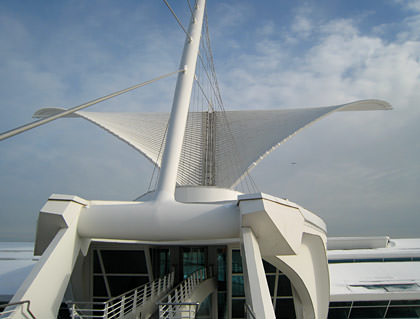
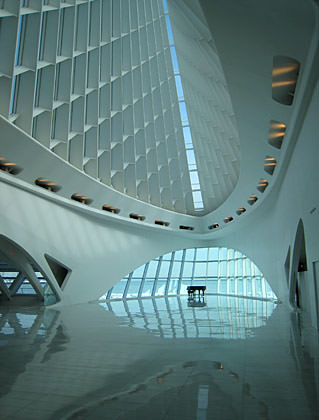
However, if you are looking for info on a pretty darn good compact camera, then by all means read onward...
PREFACE: I bought this camera unseen over the internet without reading any reviews. I knew I wanted a compact. I knew I wanted the widest angle possible on a compact. This pretty much left me with two choices that I could find... the Panasonic Lumix FX7 and the Canon
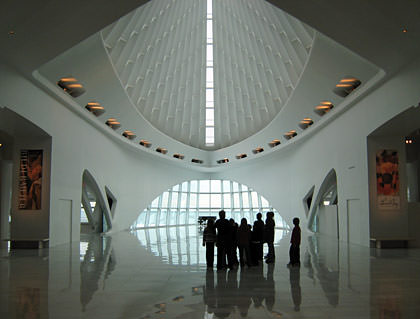
PHYSICAL ATTRIBUTES: The Canon
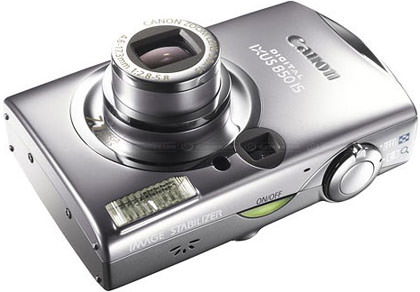
OPERATION: Other than the mode switch (play, camera, auto, camera manual, camera portrait, and movie) most every camera function is handled though Canon's excellent menu system. Despite the hundreds of options and features, the method of setting everything up is surprisingly easy and intuitive. It would take forever to list all the goodies... suffice to say most all modern digital camera features from panorama-stitch to multi-metering modes to multi-flash settings to white balance to color effects to ISO select (up to 1600!) is there. About the only notable exceptions are being able to shoot "Camera RAW" (no surprise on a small camera like this) and having "true" manual control over your shot (Canon's idea of "manual" here is pretty limited). One thing that I can't praise enough is the rapid power-on time... the camera powers up and the lens extends almost instantly, meaning you're always ready to shoot. Overall, it's got nice point-and-shoot functionality that's easy as pie to operate.
IMAGE STABILIZATION: Okay, HERE is the reason to buy this camera. Unlike many so-called "image-stabilizing" cameras which compensate for camera-shake with software, Canon has built real, physical image-stabilization into the lens. For me, this is a big, big deal. For some reason I am unable to hold a camera steady, and often end up with blurry shots no matter what I do. I remember the first outing with my Canon S400 where I was walking through Stockholm's beautiful Gamla Stan (old town) shooting everything in sight, only to get back to my hotel room and find out half of the shots were a blurry mess. Something about the tiny size of the camera makes it impossible for me to keep perfectly still, and yet turning on image-stabilization makes all my shots turn out perfectly sharp... even in low light! Absolutely love this feature, and I will never go back to a camera without true lens image-stabilization ever again...
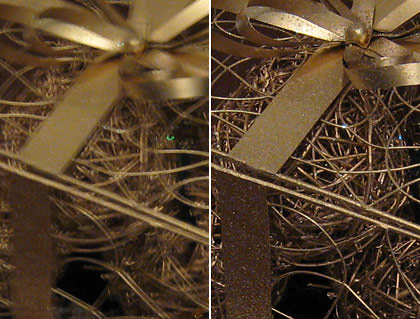
Yes. I believe the words you are looking for are "holy shit!" This is a shot into a Christmas ornament at high-zoom under low-light conditions. On the left is with I-S off, and what I'm used to getting from a compact camera. On the right is with I-S on, and what I can no longer live without. Simply brilliant.
AUTO-FOCUS: I am most pleased with the auto-focus abilities of the camera, and have yet to be disappointed... even in low-light situations. There is focus-assist strobe that clicks on in darker shots, but you can turn this off if it bothers you too much (though you will sacrifice focus when you do this if the light is dim). There is a "face detect mode" which will try to find faces to focus on, but I haven't tried this. Auto-zone focus is great, and tries to find the object to focus in on... even if it's not in the center of the frame. Shiny hi-lights, bright spots, and refractive surfaces don't seem to pose too much of a problem for the
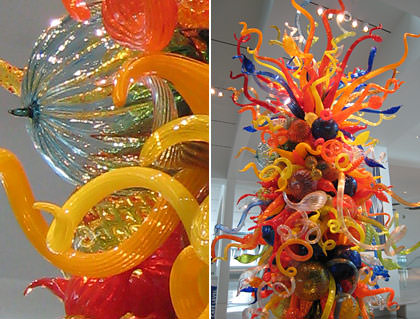
Focus-lock is easy to initiate and works as expected if you need it... but I never really had to use it because full-auto worked for me every single time in every situation I could throw at it.
FLASH: The flash is quite good. Powerful enough to light up the average room, but able to throttle back for more subtle effects. Fill-flash mode works very well for random objects I shot, and is probably amazing for portraits. There's red-eye reduction (of course) but I haven't shot any people yet to know how well it works. A good test of a flash is for situations were you have "too good lighting" and you use the flash to actually kill that blown-out glow you get from natural diffused light. I do it all the time with my digital SLR, and thought I'd try it on a poinsettia plant I found...

On the left is a flash shot that's better than the no-flash shot to the right, but not nearly as good as I could have gotten from my larger camera because there's a little too much "heat" in the center. Still, you have to admire that such a tiny flash on such a tiny camera managed to get a halfway decent fill at all.
LENS: Since much of what I like to shoot is large architectural structures or nature scenes, I really wanted a camera with wide-angle capability. The
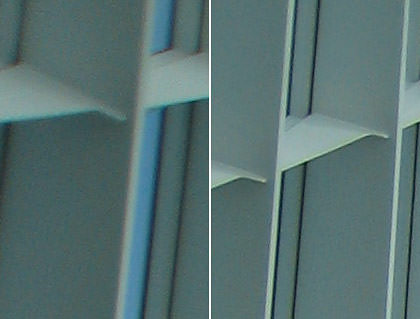
On the left side is the upper-left corner of the second shot I posted at the beginning of this entry. On the right-side is a piece of the image from a bit further in. As you can see, this blurring is pretty bad, and rears its ugly head in all four corners. At first I thought that I had a defective camera, but a quick Google search revealed that this is a known fault of the

COLOR: I've always visually preferred Sony color over Canon, because Sony seems to be a bit more warm and inviting. This has a tendency to backfire sometimes (particularly with reds, which get over-saturated), so Canon's approach is probably smarter, especially given that two seconds in Photoshop can fix any shortcomings. White balance is easy to fix, and there's a feature called "my colors" which allows some in-camera manipulation of color tone... but I mostly just go with auto and adjust as needed once I've got the image on my computer. Happily, color bleed is minimal in well-lit images, so the integrity of your photos will be quite high. The beautiful painting captured above is completely un-retouched, and shows how the
MACRO: The macro setting is kind of a blunt instrument on this camera. Sure you can get close using macro mode, but focus seems poor for shooting smaller items. It takes a lot of fidgeting with the proper balance of closeness and lens zoom to get a decent shot sometimes. A close-up of this painting was quick and painless...
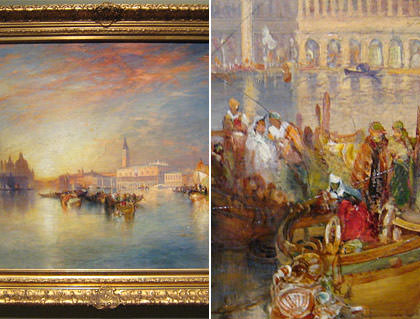
Whereas a close-up of a pine-cone and marker took way too long to figure out...
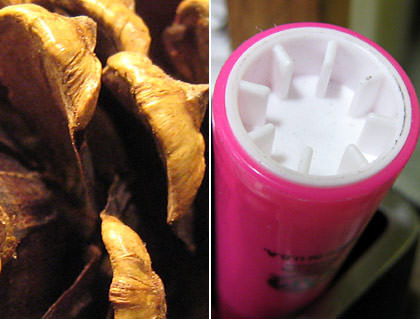
RESOLUTION DETAIL: We're quickly approaching the point where the massive pixel count of today's cameras is reaching the breaking point. This tiny camera has 7.1 megapixels, which is higher than any camera I own (including my Digital Rebel SLR). Even more amazing is that others in the sub-compact range have reached 10 megapixels. Unless you are really zooming in on something, it's questionable as to how much value this is... but I suppose it's nice to have if you need it. In the

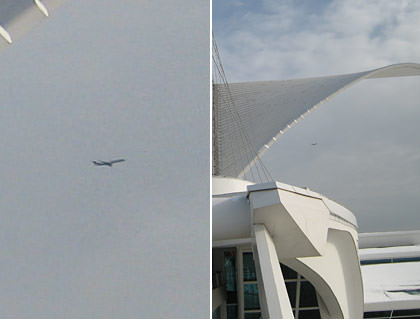
NOISE: One of the things that really kills a photo is pixel noise. Especially in low-light conditions because it can get pretty bad. The little
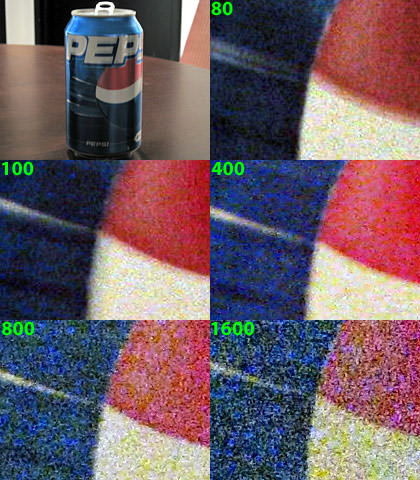
To explain here... this Pepsi can was shot under semi-low-light conditions with ISO set as indicated in the close-ups. Once I had the crops, I did an auto-levels in Photoshop so that they would all be at equal brightness. ISO 200 was almost identical to ISO 100, so I removed it. Note that even with the excellent image stabilization turned on, lower ISO settings get you some blur. And that's the trick really... shooting with an ISO low enough to minimize noise, but high enough so that you get a sharp image. Fortunately, turning the ISO to "auto" does a pretty good job of making the decision for you. At no time did I ever disagree with the setting that the camera had selected.
SOFTWARE: The camera came with a bunch of software but, since I have a Mac, I didn't bother to install any of it. With Macintosh, you have iPhoto pre-installed on all new computers, or can buy their higher-end "Aperture" program (which is what I use)... all without installing drivers. I have no idea how the crap works with Windows, but I'm guessing probably not as well. Windows totally sucks ass for stuff like this.
MEDIA: As usual with camera manufacturers, you get a wholly unusable SD memory card that's entirely too small to do anything with. The
SUMMARY: The like-ability quotient of the
Back to work...

I love comments! However, all comments are moderated, and won't appear until approved. Are you an abusive troll with nothing to contribute? Don't bother. Selling something? Don't bother. Spam linking? Don't bother.
PLEASE NOTE: My comment-spam protection requires JavaScript... if you have it turned off or are using a mobile device without JavaScript, commenting won't work. Sorry.

Hey Dave, those photos are great. That is a nice little camera!!
Wow Dave, you did a lot of beautiful work on this post and pictures. This is good enough to make it into an upscale product review consumer-type magazine, or a photography magazine. Excellent reporting, wonderful subject, good review and approach. But didn’t your car smell like pizza? I hate when that happens.
Huh. I should loan you my camera and have you write up a review, as I would never in a million years figure all this stuff out. My criteria is basically, “Fits in my purse, takes nice crisp photos.” 🙂
And speaking of, positively gorgeous photos. I didn’t know Milwaukee had such a nifty art museum!
Excellent outline of your experience with the camera! 🙂
I learned something.
I love when you do stuff like this. There is no way I’m ever going to Milwaukee, but seeing it through your eyes is wonderful!
Also, my sister, the dietician, is very concerned that you used your car for refrigeration/reheating. Literally, I had to sit through a 20 minute ‘danger zone’ lecture because I showed her this post. Thanks…:-P
Holy crap. Can you please come show me how to use my point and shoot? LOL I have an Olympus Stylus 400 that I ADORE because it’s weatherproof and perfect when we went to Disneyland and on vacation back east where it rains more than a few days a year…sounds like a good camera you got there! Maybe I should consider an upgrade. 😀
The guy who did that museum is world renowned architect Santiago Calatrava. Same guy who did the stadium for the Athens Olympics and the incredible City of Arts and Sciences in Valencia, Spain. Dunno if I’m allowed to post links, but check his page out: http://www.calatrava.com
=D
And I thought _I_ was a Canon whore. Now I want a new small camera, even though I only got mine (Ixus 55) this year. Mainly because it tops out at ISO 400 and has more noise there.
While I agree about the cheapo plastic latch for the ports, I haven’t seen one of those broken yet. So it may actually be OK quality. And as long as you only look at the camera from a distance you can’t even tell 😉
I was expecting a close-up balls shot. Not because you seem like someone who’d do that, but just because I was randomly expecting it. It would be funny.
Great post! I have been thinking about buying a digital camera, but feeling like I don’t know enough about digital photography and the assorted features to make a good decision. Reading your post gave me a much better idea of what features will be important to me.
Seriously, someone should be paying you for this stuff.
That crappy little plastic door was the FIRST thing I noticed when I bought my 630 because the second thing I did after I opened it was put in my 1meg memory card to make up for the lack of internal memory. I hate the way you have to pull the door out to flip it open. I am very concerned that those little plastic corner hinges are just going to snap off if I don’t get the door pulled out far enough before I attempt to swing it open. And that’s a pretty big issue considering you HAVE to open the door every time you use the camera because that’s where they put both the memory card AND the USB cable connector.
You’re right…”fucking stupid” describes it well.
I second RW re: your thorough review and the scalability of it…If I were a camera company, I’d sponsor you! I really appreciated this. Thanks to you Dave, I’m a little smarter now.
Your pizza story has me reminising about the days spent on the road using a cold window in a crappy hotel as a means to keep milk cold.
Ah ~ memories 🙂
Er, I meant to say 1 gig memory card, although I hear you can get 1 meg cards pretty cheap!
I’m so jealous of your new toy! 🙂
Your photos are absolutely sublimes (like always). The museum is beautiful…
You should write, review for specialized newspapers… you are a good critic !
Very nice review. If I didn’t already own two Canon cameras (and a few “retired” Nikons), I’d want to buy another. I really love Canon and that image stabilization is definitely drool-worthy.
since I’ve already conned my parents into a digital slr for christmas this year, I doubt I’llbe able to tack this on too! It looks lovely, but how easy is it to manipulate the controls and fuss with the settings? I have an older compact digital and by the time I’ve manipulated all the controls I have no interest in shooting a thing!
From my review…
“Other than the mode switch (play, camera, auto, camera manual, camera portrait, and movie) most every camera function is handled though Canon’s excellent menu system. Despite the hundreds of options and features, the method of setting everything up is surprisingly easy and intuitive.”
How does Macro work? Or, in an ideal situation, how’s it supposed to work?
I am going to stop reading this blog. It costs me a fecking fortune.
Although I already have a Canon with the Image Stabilizer (which is a godsend) I now want this as well….
I’m a camera whore.
My wife wants a new digital camera and our old Sony has given up the ghost. I will definitely look into this one.
I was at the MMA in September and totally forgot my camera! The lakefront is quite nice. I thought you weren’t supposed to take pictures of the art?!?
Canon pulls the same bs with plastic doors on their camcorders too. They could at least give it a better hinge so it’d be less likely to snap off.
Thanks for the in-depth review.
lmao at the defroster thawed pizza!
Excellent photos. I really like numbers 2 and 3 (the indoor shots)…they’re incredible. Nice, exhaustive (it was) review. Kind regards.
Your blog is such the treasure trove! I followed a link to this post from your most recent about digital cameras and what do I find in addition? Why, more information about the sculpture I liked in the Marriott in Salt Lake City.
http://flickr.com/photos/atomicbombshell/2675783685/in/set-72157606216628331/